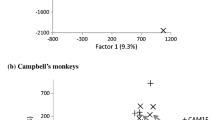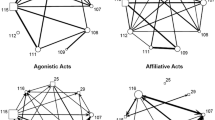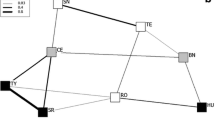Abstract
Kinship has been described as a major factor shaping primates’ social dynamics, with individuals biasing their affiliative interactions to their related counterparts. However, it has also been demonstrated that, under certain circumstances, social bonding can be established in the absence of kin. The fact that Colobus polykomos (western black-and-white colobus) and Procolobus badius temminckii (Temminck’s red colobus) often live in sympatry (subject to the same ecological/anthropogenic pressures) but exhibit contrasting social systems makes them good models to test which factors shape their social systems. We investigated the influence of kinship on intragroup social dynamics of one focal group of each species present in Cantanhez National Park, Guinea-Bissau. Between October 2008 and June 2009 we used focal sampling to collect information on the individuals’ nearest neighbors and ad libitum sampling to collect data on intragroup social interactions. We estimated pairwise relatedness using fecal DNA from 9 individuals of Colobus polykomos and 15 individuals of Procolobus badius temminckii genotyped at 15 microsatellite loci. We found that, in the focal group of Colobus polykomos, individuals showed no preference to interact or be spatially closer to related partners. Moreover, mainly unrelated females and related males composed the focal group of Procolobus badius temminckii but grooming was most frequent among female dyads and only rarely involved male dyads. We conclude that kinship is not an important factor determining the social bonding in either study species, suggesting that other factors, e.g., anthropogenic, ecological, may be at play shaping these groups’ social bonding.




Similar content being viewed by others
References
Altmann, J. (1974). Observational study of behavior: sampling methods. Behaviour, 49(3/4), 229–267.
Barton, R., Byrne, R., & Whiten, A. (1996). Ecology, feeding competition and social structure in baboons. Behavioral Ecology and Sociobiology, 38(5), 321–329.
Bates, D., Maechler, M., & Bolker, B. M. (2011). lme4: Linear mixed-effects models using S4 classes. arXiv preprint arXiv:1406.5823.
Bercovitch, F. B. (1988). Coalitions, cooperation and reproductive tactics among adult male baboons. Animal Behaviour, 36(4), 1198–1209.
Bolker, B. M., Brooks, M. E., Clark, C. J., Geange, S. W., Poulsen, J. R., Stevens, M. H. H., & White, J.-S. S. (2009). Generalized linear mixed models: a practical guide for ecology and evolution. Trends in Ecology & Evolution, 24(3), 127–135.
Carvalho, J. S., Marques, T. A., & Vicente, L. (2013). Population status of Pan troglodytes verus in Lagoas de Cufada Natural Park, Guinea-Bissau. PloS One, 8(8), e71527.
Chapais, B. (2001). Primate nepotism: what is the explanatory value of kin selection? International Journal of Primatology, 22(2), 203–229.
Connor, R. C., Heithaus, M. R., & Barre, L. M. (2001). Complex social structure, alliance stability and mating access in a bottlenose dolphin ‘super-alliance.’. Proceedings of the Royal Society of London B: Biological Sciences, 268(1464), 263–267.
Costa, S., Casanova, C., Sousa, C., & Lee, P. (2013). The good, the bad and the ugly: perceptions of wildlife in Tombali (Guinea-Bissau, West Africa). Journal of Primatology, 2(110), 2.
Dasilva, G. L. (1989). The ecology of the western black and white colobus (Colobus polykomos polykomos, Zimmerman 1780) on a riverine island in southeastern Sierra Leone. Ph.D. dissertation, University of Oxford.
Decker, B. S. (1994). Effects of habitat disturbance on the behavioral ecology and demographics of the Tana River red colobus (Colobus b. rufomitratus). International Journal of Primatology, 15(5), 703–737.
Di Fiore, A. (2003). Molecular genetic approaches to the study of primate behaviour, social organization, and reproduction. American Journal of Physical Anthropology, 46(37), 62–99.
Di Fiore, A., & Rodman, P. S. (2001). Time allocation patterns of lowland woolly monkeys (Lagothrix lagotricha poeppigii) in a neotropical terra firma forest. International Journal of Primatology, 22(3), 449–480.
Dobson, A. J., & Barnett, A. (2002). An introduction to generalized linear models. Boca Raton: Chapman & Hall/CRC Press.
Fleury, M. C., & Gautier-Hion, A. (1999). Semi-nomadic ranging behavior in a population of black colobus (Colobus satanas) in Gabon and its ecological correlates. International Journal of Primatology, 20(5), 491–509.
Frankham, R. (2006). Genetics and landscape connectivity. In K. R. Crooks & M. Sanjayan (Eds.), Connectivity conservation (pp. 72–96). Cambridge: Cambridge University Press.
Gagneux, P., Boesch, C., & Woodruff, D. S. (1999). Female reproductive strategies, paternity and community structure in wild West African chimpanzees. Animal Behaviour, 57(1), 19–32.
Galat, G., & Galat-Luong, A. (1985). La communauté de primates diurnes de la forêt de Tai, Côte d’Ivoire. Revue d’Ecologie (Terre Vie), 40(1), 3–32.
Gouzoules, H., & Gouzoules, S. (1987). Kinship. In B. B. Smuts, D. L. Cheney, R. M. Seyfarth, R. W. Wrangham, & T. T. Struthsaker (Eds.), Primate societies (pp. 299–305). Chicago: University of Chicago Press.
Hamilton, W. D. (1964a). The genetical evolution of social behavior I. Journal of Theoretical Biology, 7(1), 1–16.
Hamilton, W. D. (1964b). The genetical evolution of social behavior II. Journal of Theoretical Biology, 7(1), 17–52.
Harris, T. R., Caillaud, D., Chapman, C., & Vigilant, L. (2009). Neither genetic nor observational data alone are sufficient for understanding sex-biased dispersal in a social-group-living species. Molecular Ecology, 18(8), 1777–1790.
Hockings, K. J., Anderson, J. R., & Matsuzawa, T. (2012). Socioecological adaptations by chimpanzees, Pan troglodytes verus, inhabiting an anthropogenically impacted habitat. Animal Behaviour, 83(3), 801–810.
Hockings, K. J., McLennan, M. R., Carvalho, S., Ancrenaz, M., Bobe, R., Byrne, R. W., et al. (2015). Apes in the anthropocene: flexibility and survival. Trends in Ecology & Evolution, 30(4), 215–222.
Hockings, K. J., & Sousa, C. (2013). Human-chimpanzee sympatry and interactions in Cantanhez National Park, Guinea-Bissau: current research and future directions. Primate Conservation, 26(1), 57–65.
Isbell, L. A. (2004). Is there no place like home? Ecological bases of female dispersal and philopatry and their consequences for the formation of kin groups. In B. Chapais & C. M. Berman (Eds.), Kinship and behaviour in primates (pp. 71–109). Oxford: Oxford University Press.
Isbell, L. A., & van Vuren, D. (1996). Differential costs of locational and social dispersal and their consequences for female group living primates. Behaviour, 133(1/2), 1–36.
Konovalov, D. A., Manning, C., & Henshaw, M. T. (2004). KINGROUP: a program for pedigree relationship reconstruction and kin group assignments using genetic markers. Molecular Ecology Notes, 4(4), 779–782.
Korstjens, A. H. (2001). The mob, the secret sorority, and the phantoms: An analysis of the socio-ecological strategies of the three colobines of Tai. Ph.D. dissertation, Utrecht University.
Korstjens, A. H., Nijssen, E. C., & Noë, R. (2005). Intergroup relationships in western black-and-white colobus, Colobus polykomos polykomos. International Journal of Primatology, 26(6), 1267–1289.
Korstjens, A. H., Sterck, E. H. M., & Noë, R. (2002). How adaptive or phylogenetically inert is primate social behaviour? A test with two sympatric colobines. Behaviour, 139(2–3), 203–225.
Lehmann, J., & Boesch, C. (2009). Sociality of the dispersing sex: the nature of social bonds in West African female chimpanzees, Pan troglodytes. Animal Behavior, 77(2), 377–387.
Lynch, M., & Ritland, K. (1999). Estimation of pairwise relatedness with molecular markers. Genetics, 152(4), 1753–1766.
McDonald, D. B., & Potts, W. K. (1994). Cooperative displays and relatedness among males in a lek-mating bird. Science, 266(5187), 1030–1032.
Ménard, N., Motsch, P., Delahaye, A., Saintvanne, A., Le Flohic, G., Dupé, S. et al. (2013). Effect of habitat quality on the ecological behaviour of a temperate-living primate: time-budget adjustments. Primates, 54(3), 217–228.
Minhós, T., Nixon, L., Sousa, C., Vicente, L., Ferreira da Silva, M., Sá, R., & Bruford, M. W. (2013a). Genetic evidence for spatio-temporal changes in the dispersal patterns of two sympatric African colobine monkeys. American Journal of Physical Anthropology, 150(3), 464–474.
Minhós, T., Sá, R., Ferreira da Silva, M., Wallace, E., Barata, A., Carmo, M., & Bruford, M. W. (2013b). DNA identification of primate bushmeat from urban markets in Guinea-Bissau and its implications for conservation. Biological Conservation, 167, 43–49.
Mortelliti, A., Amori, G., & Boitani, L. (2010). The role of habitat quality in fragmented landscapes: a conceptual overview and prospectus for future research. Oecologia, 163(2), 535–547.
Oates, J. F. (1977). The social life of black-and-white colobus monkey, Colobus guereza. Zeitschrift für Tierpsychologie, 45(1), 1–60.
Oates, J. F., Gippoliti, S., & Groves, C. P. (2008a). Colobus polykomos. In IUCN 2010. IUCN red list of threatened species. Version 2010.4. Available at www.iucnredlist.org.
Oates, J. F., Struhsaker, T., McGraw, S., et al. (2008b). Procolobus badius. In IUCN 2011. IUCN red list of threatened species. Version 2011.2. Available at www.iucnredlist.org.
Onderdonk, D. A., & Chapman, C. A. (2000). Coping with forest fragmentation: the primates of Kibale National Park, Uganda. International Journal of Primatology, 12(4), 587–611.
Pamilo, P., & Crozier, R. H. (1982). Measuring genetic relatedness in natural populations: methodology. Theoretical Population Biology, 21(2), 171–193.
Queller, D. C., & Goodnight, K. F. (1989). Estimating relatedness using genetic markers. Evolution, 43, 258–275.
R Development Core Team. (2009). R: A language and environment for statistical computing. Rel. 2.10.0. Vienna: Foundation for Statistical Computing.
R Development Core Team. (2012). R: A language and environment for statistical computing. Vienna, Austria: R Foundation for Statistical Computing.
Sá, R. M., Petrásová, J., Pomajbíková, K., Profousová, I., Petrzelková, K. J., Sousa, C., & Modry, D. (2013). Gastrointestinal symbionts of chimpanzees in Cantanhez National Park, Guinea‐Bissau with respect to habitat fragmentation. American Journal of Primatology, 75(10), 1032–1041.
Seyfarth, R. M. (1977). A model of social grooming among adult female monkeys. Journal of Theoretical Biology, 65, 671–698.
Siex, K. S. (2003). Effects of population compression on the demography, ecology, and behavior of the Zanzibar red colobus monkey (P. kirkii). Ph.D. dissertation, Duke University.
Silk, J. B. (1987). Social behavior in evolutionary perspective. In B. B. Smuts, D. L. Cheney, R. M. Seyfarth, R. W. Wrangham, & T. T. Struthsaker (Eds.), Primate societies (pp. 318–329). Chicago: University of Chicago Press.
Silk, J. B. (2002). Kin selection in primate groups. International Journal of Primatology, 23(4), 849–875.
Simão, A. (1997). Identificação e delimitação cartográfica dos grandes maciços florestais de Cantanhez. Relatório de Missão. Acção para o Desenvolvimento: Bissau, Republica da Guiné-Bissau. Acção para o Desemvolvimento, Républica da Guiné-Bissau.
Sousa, J., Barata, A., Sousa, C., Casanova, C., & Vicente, L. (2011). Chimpanzee oil palm use in southern Cantanhez National Park, Guinea-Bissau. American Journal of Primatology, 73(5), 485–497.
Starin, E. D. (1991). Socioecology of the red colobus in the Gambia with particular reference to female-male differences and transfer patterns. Ph.D. dissertation, The City University of New York.
Starin, E. D. (1994). Philopatry and affiliation among red colobus. Behaviour, 130, 253–270.
Struhsaker, T. T. (1975). The red colobus monkey. Chicago: University of Chicago Press.
Struhsaker, T. T. (2010). The red colobus monkeys: Variation in demography, behaviour and ecology of an endangered species. Oxford: Oxford University Press.
Struhsaker, T. T., & Leland, L. (1979). Socioecology of two sympatric monkey species in the Kibale Forest, Uganda. In J. Rosenblatt, R. A. Hinde, A. Beer, & M. C. Busnel (Eds.), Advances in the study of behavior, vol. 9 (pp. 158–228). New York: Academic Press.
Struhsaker, T. T., & Oates, J. F. (1975). Comparison of the behaviour and ecology of red colobus and black-and-white colobus monkeys in Uganda: A summary. In R. H. Tuttle (Ed.), Socioecology and psychology of primates (pp. 103–123). The Hague: Mouton.
Teichroeb, J. A., Wikberg, E. C., & Sicotte, P. (2009). Female dispersal patterns in six groups of ursine colobus (Colobus vellerosus): infanticide avoidance is important. Behaviour, 146(4–5), 551–582.
Tutin, C. E. (1999). Fragmented living: behavioural ecology of primates in a forest fragment in the Lopé Reserve, Gabon. Primates, 40(1), 249–265.
van Hooff, J. A. R. A. M. (2000). Relationships among non-human primate males: a deductive framework. In P. Kappeler (Ed.), Primate males: Causes and consequences of variation in group composition (pp. 183–191). Cambridge: Cambridge University Press.
Vigilant, L., Hofreiter, M., Siedel, H., & Boesch, C. (2001). Paternity and relatedness in wild chimpanzee communities. Proceedings of the National Academy of Sciences of the United States of America, 98(23), 12890–12895.
Villard, M. A. (2002). Habitat fragmentation: major conservation issue or intellectual attractor? Ecological Applications, 12(2), 319–320.
Watts, D., & Mitani, J. (2001). Boundary patrols and intergroup encounters among wild chimpanzees. Behaviour, 138(3), 299–327.
Wieczkowski, J. (2005). Examination of increased annual range of a Tana mangabey (Cercocebus galeritus) group. American Journal of Physical Anthropology, 128(2), 381–388.
Wikberg, E. C., Sicotte, P., Campos, F. A., & Ting, N. (2012). Between-group variation in female dispersal, kin composition of groups, and proximity patterns in a black-and-white colobus monkey (Colobus vellerosus). PloS One, 7(11), e48740.
Wikberg, E. C., Ting, N., & Sicotte, P. (2014). Kinship and similarity in residency status structure female social networks in black-and-white colobus monkeys (Colobus vellerosus). American Journal of Physical Anthropology, 153(3), 365–376.
Wrangham, R. W., & Peterson, D. (1996). Demonic males. New York: Houghton Mifflin.
Acknowledgments
This study was financed by a Fundação para a Ciência e Tecnologia grant (SFRH/BPD/87396/2012) to T. Minhós. We thank Institute of Biodiversity and Protected Areas (IBAP) in Guinea-Bissau for facilitating fieldwork in Guinea-Bissau and providing logistical support. We thank Forestry and Fauna Department (DGFC) and Action for Development (AD) for field assistance and permits and National Institute for Studies and Research (INEP) and Gabinete de Planificação Costeira for providing us with the land cover maps. We sincerely thank Mutaro Galiza, Mamadu (Catomboi), and Saido Kuiaté for the great assistance in the field, helping in the data collection and the local community for welcoming us. We also thank Maria Ferreira da Silva and Rui Sá for the great discussions and their insights across all stages of the work; K. Hockings, C. Casanova A. Barata, and M. Carmo for the great insights during fieldwork; and J. Carvalho for the help with statistical analyses. Finally, we thank the Editor-in-Chief Dr Joanna M Setchell, the Associate Editor James Higham, two anonymous reviewers, and D. Starin, K. Hockings, and R. Xavier for the helpful comments that improved the quality of the manuscript.
Author information
Authors and Affiliations
Corresponding author
Rights and permissions
About this article
Cite this article
Minhós, T., Sousa, C., Vicente, L.M. et al. Kinship and Intragroup Social Dynamics in Two Sympatric African Colobus Species. Int J Primatol 36, 871–886 (2015). https://doi.org/10.1007/s10764-015-9859-8
Received:
Accepted:
Published:
Issue Date:
DOI: https://doi.org/10.1007/s10764-015-9859-8




